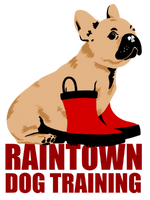Dog to Dog Body Language
Is it play or is it a fight? How to read dog-To-dog body language
By Kris Hampton at Raintown Dog Training
What is your dog ‘saying’ to another dog when they interact? Is it a friendly greeting, some rough play, or a straight-up dog fight? Read professional dog trainer Kris Hampton’s tips on how to read dog-to-dog body language and gain confidence on your next trip to the dog park.
What are the Play Behaviours?
It’s key to remember that all play is a ‘pulled back’ version of fighting, fleeing, feeding, and courtship. During a dog play session, we might see play fighting (wrestling, biting, pinning), play fleeing (soliciting chase, running away), play hunting (chasing, biting, grab/shake), and play courtship (mounting, clasping). So, how do we know it’s play rather than an actual fight?
When dogs are in the middle of a play session, we’ll see play meta-signals. These signals from one dog to another qualify the play intent of behaviours they proceed and follow. They are pro-social, and communicate ‘this is all just for fun!’. Examples of meta-signals include:
Lip-licking or tongue flicks
Also known as ‘snake tongue’. Your dog may be attempting to appease with some lip-licking (‘I’m not a threat!’). I often see this when a novel dog approaches a dog for the first time.
You might also see this when a dog is slightly nervous - so keep an eye on the rest of your dog’s body to determine whether this is play intent or a sign of stress.
Ears high and rotated back
Also known as ‘play ears’. I often see these cute ears rotate back shortly before a burst of chase or a play bow.
Chuffing
A cross between an exhale and a bark, excess energy is burnt off with a chuff. I find these particularly cute.
Standing for investigation
‘Yes, you can sniff me!’
Play face
This is a big one in the play world. It’s something you ‘know when you see it’. A play face could include relaxed eyebrows and an open mouth.
Play bow
Another big play signal, a play bow is a personal favourite. When a dog places their chest on the ground with their behind in the air in a ‘downward-facing-dog’ type yoga position, it’s as if they are winking and saying ‘all of this, it’s just for fun’.
Paw raise
This is a big meta signal in puppies especially, and is generally seen as pro-social, if a little ambivalent or shy.
Self-handicapping
‘You’re smaller and/or weaker than me, let me pull my punches more!’ I love dogs that self-handicap during play. Seeing a large dog sploot on the ground and move ever so slowly so that their more shy or small play-partner has an equal match warms my heart every time.
Bouncy exaggerated movements
Another biggie in the play world, bouncy and inefficient movements signal play. Think of a rocking horse moving back-and-forth; we love to see bouncy play.
Role-reversal or activity shift
‘You chase me, now I’ll chase you! Now I’ll pin you! Now you pin me!’ While it doesn’t need to be 50-50, we want to see a lot of give-and-take in play.
What are the Anti-Social Behaviours?
So, what about when it’s not play? When dogs are feeling antisocial and are at risk of a fight, we’ll see the following body language signals:
Whale eye
Also known as ‘side eye’ or ‘hard eye’, your dog may be turning their head away but looking at you out of the corner of their eye so that the whites of their eyes are showing.
Vertical lip retraction
Also known as a snarl, your dog’s upper lip is curling upwards. ‘Back off please!’
A Growl
This might be a low and continuous growl, or a growl that ‘revvs up’ like a motorbike.
Dogs often growl during play as well, so keep an eye on the rest of your dog’s body to determine whether this is play intent or a warning sign.
Snap
A quick snap of the mouth, either making contact with your skin or an ‘air snap’
Freeze
Your dog might cease eating suddenly (if eating) or exhibit stiff, waxy movements.
Pinning
You dog may pin another dog down and not tolerate movement
Avoidance/flight/hiding
Tucking between your legs, under chairs, or in corners is a sure sign of a nervous dog who is not feeling playful. It’s important to let dogs have spaces to retreat to safely if they’re feeling anti-social!
Bite
Pretty self-explanatory. Not a mouthing-type play-bite.
Fighting
Snarling, lunging, snapping and/or biting while making contact with another dog is a fight that needs to be broken up ASAP.
What’s The Trend?
Remember that a body language behaviour in isolation doesn’t necessarily dictate the entirety of your dog’s intent in any given moment. I could laugh when nervous or when happy. I could feel both anxious and excited at any given moment. It’s not so different with dogs.
What makes it play is not the absence of fighting, chasing, hunting and courting behaviours but the presence of play meta-signals. We want to see an upward trend of prosocial behaviour, and a downward trend of antisocial behaviours.
Next time you’re at the dog park, how many meta-signals and anti-social behaviours can you spot between dogs?


